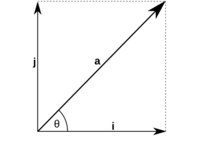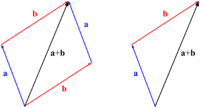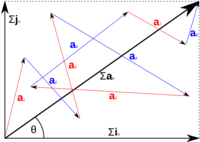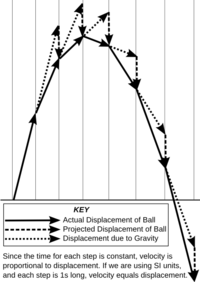A-level Physics (Advancing Physics)/Vectors
< A-level Physics (Advancing Physics)What is a vector?
Two types of physical quantity are scalars and vectors. Scalar quantities are simple: they are things like speed, distance, or time. They have a magnitude, but no direction. A vector quantity consists of two parts: both a scalar and a direction. For example, the velocity of an object is made up of both the speed of an object and the direction in which it is moving. Speed is a scalar; add a direction and it becomes velocity, a vector. Similarly, take a distance and give it a direction and it becomes a displacement, such as '2 miles south-east'. Distance is a scalar, whereas displacement is a vector.
Vectors and scalars are both useful. For example, if I run around the room several times and end up back where I started, I may have covered a distance of 50m. My displacement is 0 - the null vector. The null vector is the only vector which has no direction. If I want to calculate how much work I have done, I should use the distance. If I want to know where I am, I should use the displacement.
As we shall see, the directional component of a vector can be expressed in several different ways. '2 miles south-east' is the same as saying '2 miles on a bearing of 135°', or '1.4 miles east, -1.4 miles north'. The scalar component of a vector is known as the modulus of a vector.
Vector Notation
You need to be able to understand the following algebraic representations of vectors:
| Symbol | Meaning |
| A vector from point a to point b. | |
| a | A vector named 'a'. This is used in typed algebra. |
| a | A vector named 'a'. This is used in handwritten algebra. |
| or |a| or |a| | The modulus of a vector. |
Vector Components

Sometimes, it is useful to express a vector in terms of two other vectors. These two vectors are usually pointing up and right, and work similarly to the Cartesian co-ordinate system. So, for example, 'an acceleration of 3.4 ms-2 west' becomes 'a vertical acceleration of 0 ms-2 and an horizontal acceleration of -3.4 ms-2 east. However, this is a very simple example.
Consider the diagram on the right. The vector a consists of a vertical component j and a horizontal component i. a has a modulus |a|. |i| and |j| can be calculated using |a|, the angle between i and a θ and some basic trigonometry. We know that:
and
Hence:
|i| = |a| cos θ and |j| = |a| sin θ.
This will be given to you in the formula booklet in the exam.
Vector Addition

You also need to know how to add vectors together. This enables us to answer questions such as, "If I travel 5 miles north-west and then 6 miles east, where am I?", or "If I accelerate at 3 ms-2 in a northerly direction, and accelerate south-east at 1 ms-2, what is my total acceleration?". Vectors can be added 'tip-to-tail'; that is to say, the resultant vector is equal to 'travelling' the first vector, and then travelling the second vector.
This is shown in the diagram on the left. When vectors a and b are added together, the resultant vector a + b is produced, joining the tail of the first vector to the tip of the last, with the vectors joined together. In practise, the easiest way to add two vectors together is to calculate (if you do not already know this) the vertical and horizontal components, and add them all together to get two total vertical and horizontal components. You can then use Pythagoras' theorem to calculate the modulus of the resultant vector, and some more basic trigonometry to calculate its direction.

In algebra:
and ,
where a1 ... an are the vectors to be added together, i1 ... in are their horizontal components, j1 ... jn are their vertical components, and θ is the angle between the θ=0 line and the resultant vector Σan, as shown in the diagram on the right.
Predicting Parabolas

If you use a diagram to represent vectors (making the lengths of the arrows proportional to the modulus of the vectors they represent, and the directions equal), you can predict graphically the trajectory an object (such as a ball) will take. Use the following steps:
- Draw a vector to represent the velocity of the ball (in ms-1). Since this is the number of metres travelled in 1 second, and each step of the process is 1 second long, this vector represents both the velocity and the displacement of the ball, i.e.
- Copy this vector, and connect its tail to the tip of the first vector. This new vector represents the velocity and displacement that the ball would have had over the next second, if gravity did not exist.
- Draw another vector to represent the change in velocity due to gravity (9.81 ms-2) on Earth. This should be pointing downwards, and be to the same scale as the other vectors. This represents the fact that the velocity of the ball changes due to gravity (velocity is a vector, so both the speed and angle of the ball's travel change).
- Add these vectors together, as shown above, to give a new vector. This new vector represents the velocity and displacement of the ball over the second second.
- Repeat this process until the ball hits something (draw the ground, if in doubt).
Questions
1. Which of the following are vectors?
- 20 cm
- 9.81 ms-2 towards the centre of the earth
- 5 km south-east
- 500 ms-1 on a bearing of 285.3°
2. A displacement vector a is the resultant vector of two other vectors, 5 m north and 10 m south-east. What does a equal, as a displacement and a bearing?
3. If I travel at a velocity of 10 ms-1 on a bearing of 030°, at what velocity am I travelling north and east?
4. An alternative method of writing vectors is in a column, as follows:
,
where x and y are the vertical and horizontal components of the vector respectively. Express |a| and the angle between a and in terms of x and y.
5. A more accurate method of modelling the trajectory of a ball is to include air resistance as a constant force F. How would this be achieved?